Current Status of Image Recognition Technology in the Field of Corrosion Protection Applications
Abstract
1. Introduction
2. General Steps in Image Recognition Techniques
2.1. Traditional Image Recognition Steps
2.1.1. Image Acquisition Collection
2.1.2. Image Pre-Processing
2.1.3. Feature Extraction
2.1.4. Image Classification
2.2. Deep Learning-Based Image Recognition
3. Identification of Metals
3.1. Traditional Methods
3.1.1. Wavelet Transform-Based Approach
3.1.2. Approaches Based on Fractal Theory
3.1.3. Methods Based on Grayscale Images
3.2. Deep Learning-Based Approach
4. Recognition and Mining of Corrosion Data Images
5. Identification of Coatings
5.1. Traditional Methods
5.2. Deep Learning Image Recognition Algorithm
6. Future Outlook
7. Conclusions
- Traditional methods have been effectively used for detecting cracks, pitting, and other defects in steel structures. By analyzing collected images of corroded steel, extracting corrosion features, and applying mathematical methods to mine the deep features of grayscale images, it is possible to distinguish between various corrosion morphologies. However, these models often lack generalization, meaning that changes in the environment and the recognition object can greatly affect the accuracy. Additionally, selecting the right model and extracting features can be complex. Deep learning methods, which require a large number of steel surface topography images, offer a solution where different application scenarios can use the same model, albeit with different datasets.
- By analyzing images of changes in electrochemical parameters during metal corrosion, deeper corrosion information can be extracted, such as determining equivalent circuit diagrams and predicting the lifetime of coatings.
- Traditional image recognition methods for coatings are similar to those used for metals. However, deep learning image recognition algorithms show more potential in recognizing the boundary, thickness, and uniformity of coatings.
Funding
Institutional Review Board Statement
Informed Consent Statement
Data Availability Statement
Acknowledgments
Conflicts of Interest
References
- Hou, B.; Li, X.; Ma, X.; Du, C.; Zhang, D.; Zheng, M.; Xu, W.; Lu, D.; Ma, F. The cost of corrosion in China. NPJ Mater. Degrad. 2017, 1, 4. [Google Scholar] [CrossRef]
- Hou, B.; Zhang, D.; Wang, P. Marine Corrosion and Protection: Current Status and Prospect. Bull. Chin. Acad. Sci. 2016, 31, 1326–1331. [Google Scholar]
- Qiao, D.; Yan, J.; Ou, J. Fatigue analysis of deepwater hybrid mooring line under corrosion effect. Pol. Marit. Res. 2014, 21, 68–76. [Google Scholar] [CrossRef]
- Zayed, A.; Garbatov, Y.; Guedes Soares, C. Corrosion degradation of ship hull steel plates accounting for local environmental conditions. Ocean. Eng. 2018, 163, 299–306. [Google Scholar] [CrossRef]
- Gudze, M.T.; Melchsers, R.E. Operational based corrosion analysis in naval ships. Corros. Sci. 2008, 50, 3296–3307. [Google Scholar] [CrossRef]
- Akhlaghi, B.; Mesghali, H.; Ehteshami, M.; Mohammadpour, J.; Salehi, F.; Abbassi, R. Predictive deep learning for pitting corrosion modeling in buried transmission pipelines. Process. Saf. Environ. Prot. 2023, 174, 320–327. [Google Scholar] [CrossRef]
- Bhandari, J.; Khan, F.; Abbassi, R.; Garaniya, V.; Ojeda, R. Modelling of pitting corrosion in marine and offshore steel structures—A technical review. J. Loss Prev. Process. Ind. 2015, 37, 39–62. [Google Scholar] [CrossRef]
- Alcantara, J.; de la Fuente, D.; Chico, B.; Simancas, J.; Diaz, I.; Morcillo, M. Marine Atmospheric Corrosion of Carbon Steel: A Review. Materials 2017, 10, 406. [Google Scholar] [CrossRef]
- Huang, J.; Meng, X.; Huang, Y.; Jiang, W.; Chen, R.; Zheng, Z.; Gao, Y. Atmospheric corrosion of carbon steels in tropical and subtropical climates in Southern China. Mater. Corros. Werkst. Und Korros. 2020, 71, 1400–1406. [Google Scholar] [CrossRef]
- Lv, S.; Li, K. Semiconducting Behaviour and Corrosion Resistance of Passive Film on Corrosion-Resistant Steel Rebars. Materials 2022, 15, 7644. [Google Scholar] [CrossRef]
- Kausar, A.; Ahmad, I.; Bocchetta, P. High-Performance Corrosion-Resistant Polymer/Graphene Nanomaterials for Biomedical Relevance. J. Compos. Sci. 2022, 6, 362. [Google Scholar] [CrossRef]
- Wang, Q.; Wang, R.; Zhang, Q.; Zhao, C.; Zhou, X.; Zheng, H.; Zhang, R.; Sun, Y.; Yan, Z. Application of Biomass Corrosion Inhibitors in Metal Corrosion Control: A Review. Molecules 2023, 28, 2832. [Google Scholar] [CrossRef] [PubMed]
- Li, H.; Si, S.; Yang, K.; Mao, Z.; Sun, Y.; Cao, X.; Yu, H.; Zhang, J.; Ding, C.; Liang, H.; et al. Hexafluoroisopropanol based silk fibroin coatings on AZ31 biometals with enhanced adhesion, corrosion resistance and biocompatibility. Prog. Org. Coat. 2023, 184, 107881. [Google Scholar] [CrossRef]
- Gnedenkov, A.S.; Filonina, V.S.; Sinebryukhov, S.L.; Gnedenkov, S.V. A Superior Corrosion Protection of Mg Alloy via Smart Nontoxic Hybrid Inhibitor -Containing Coatings. Molecules 2023, 28, 2538. [Google Scholar] [CrossRef] [PubMed]
- Yang, C.; Xu, W.; Meng, X.; Shi, X.; Shao, L.; Zeng, X.; Yang, Z.; Li, S.; Liu, Y.; Xia, X. A pH-responsive hydrophilic controlled release system based on ZIF-8 for self-healing anticorrosion application. Chem. Eng. J. 2021, 415, 128985. [Google Scholar] [CrossRef]
- Zhang, B.; Li, L.; Zhang, Y.; Wang, J. Study on the Interference Law of AC Transmission Lines on the Cathodic Protection Potential of Long-Distance Transmission Pipelines. Magnetochemistry 2023, 9, 75. [Google Scholar] [CrossRef]
- Erdogan, C.; Swain, G. Conceptual Sacrificial Anode Cathodic Protection Design for offshore wind monopiles. Ocean. Eng. 2021, 235, 109339. [Google Scholar] [CrossRef]
- Gusev, B.V.; Fedotov, M.Y.; Leshchenko, V.V.; Lepikhin, A.M.; Makhutov, N.A.; Budadin, O.N. Nondestructive Testing of Offshore Subsea Pipelines and Calculation Substantiation of their Safety According to Risk Criteria. Chem. Pet. Eng. 2023, 58, 776–787. [Google Scholar] [CrossRef]
- Siang, T.W.; Akbar, M.F.; Jawad, G.N.; Yee, T.S.; Sazali, M.I.S.M. A Past, Present, and Prospective Review on Microwave Nondestructive Evaluation of Composite Coatings. Coatings 2021, 11, 913. [Google Scholar] [CrossRef]
- Tonga, D.A.; Akbar, M.F.; Shrifan, N.H.M.M.; Jawad, G.N.; Ghazali, N.A.; Packeer Mohamed, M.F.; Al-Gburi, A.J.A.; Ab Wahab, M.N. Nondestructive Evaluation of Fiber-Reinforced Polymer Using Microwave Techniques: A Review. Coatings 2023, 13, 590. [Google Scholar] [CrossRef]
- Gong, W.; Akbar, M.F.; Jawad, G.N.; Mohamed, M.F.P.; Ab Wahab, M.N. Nondestructive Testing Technologies for Rail Inspection: A Review. Coatings 2022, 12, 1790. [Google Scholar] [CrossRef]
- Wasif, R.; Tokhi, M.O.; Shirkoohi, G.; Marks, R.; Rudlin, J. Development of Permanently Installed Magnetic Eddy Current Sensor for Corrosion Monitoring of Ferromagnetic Pipelines. Appl. Sci. 2022, 12, 1037. [Google Scholar] [CrossRef]
- Liu, X.F.; Wang, H.G.; Huang, S.J.; Gu, H.C. Analysis of electrochemical noise with wavelet transform. Corrosion 2001, 57, 843–852. [Google Scholar] [CrossRef]
- Zhu, Y.; Wang, L.; Behnamian, Y.; Song, S.; Wang, R.; Gao, Z.; Hu, W.; Xia, D.-H. Metal pitting corrosion characterized by scanning acoustic microscopy and binary image processing. Corros. Sci. 2020, 170, 108685. [Google Scholar] [CrossRef]
- Haigler, T. Introduction of NDT Methods and Techniques in Power Plants. Mater. Eval. 2020, 78, 1094–1096. [Google Scholar] [CrossRef]
- He, D.; Kusano, M.; Watanabe, M. Detecting the defects of warm-sprayed Ti-6Al-4V coating using Eddy current testing method. Ndt E Int. 2022, 125, 102565. [Google Scholar] [CrossRef]
- Movafeghi, A.; Mohammadzadeh, N.; Yahaghi, E.; Nekouei, J.; Rostami, P.; Moradi, G. Defect Detection of Industrial Radiography Images of Ammonia Pipes by a Sparse Coding Model. J. Nondestruct. Eval. 2018, 37, 3. [Google Scholar] [CrossRef]
- Wang, C.; Li, W.; Xin, G.; Wang, Y.; Xu, S.; Fan, M. Novel method for prediction of corrosion current density of gas pipeline steel under stray current interference based on hybrid LWQPSO-NN model. Measurement 2022, 200, 111592. [Google Scholar] [CrossRef]
- Agarwal, A.; Sharma, V.; Shukla, V.; Yadav, B.P.; Singh, R. IoT-and NDT-Based Bridge Risk Assessment and Identification. In Proceedings of the International Conference on Advances in the Field of Health, Safety, Fire, Environment, Allied Sciences and Engineering (HSFEA), Dehradun, India, 28 June 2018. [Google Scholar]
- Camponeschi, E.T., Jr.; Crane, R.; Bandos, B. The role and use of nondestructive testing for US navy composite ship structures. Mater. Eval. 2007, 65, 752–758. [Google Scholar]
- Fajardo, J.I.; Paltan, C.A.; Lopez, L.M.; Carrasquero, E.J. Textural analysis by means of a gray level co-occurrence matrix method. Case: Corrosion in steam piping systems. Mater. Today Proc. 2022, 49, 149–154. [Google Scholar] [CrossRef]
- Lin, Z.; Zhang, W.; Li, J.; Yang, J.; Han, B.; Xie, P. Application of artificial intelligence (AI) in the area of corrosion protection. Anti-Corros. Methods Mater. 2023, 70, 243–251. [Google Scholar] [CrossRef]
- Feiler, C.; Mei, D.; Vaghefinazari, B.; Wuerger, T.; Meissner, R.H.; Luthringer-Feyerabend, B.J.C.; Winkler, D.A.; Zheludkevich, M.L.; Lamaka, S.V. In silico screening of modulators of magnesium dissolution. Corros. Sci. 2020, 163, 108245. [Google Scholar] [CrossRef]
- Chae, Y.H.; Kim, S.G.; Kim, H.; Kim, J.T.; Seong, P.H. A methodology for diagnosing FAC induced pipe thinning using accelerometers and deep learning models. Ann. Nucl. Energy 2020, 143, 107501. [Google Scholar] [CrossRef]
- Zhi, Y.; Yang, T.; Fu, D. An improved deep forest model for forecasting the outdoor atmospheric corrosion rate of low-alloy steels. J. Mater. Sci. Technol. 2020, 49, 202–210. [Google Scholar] [CrossRef]
- Naladala, I.; Raju, A.; Aishwarya, C.; Koolagudi, S.G. Corrosion Damage Identification and Lifetime Estimation of Ship Parts using Image Processing. In Proceedings of the 7th International Conference on Computing, Communications and Informatics (ICACCI), Bangalore, India, 19–22 September 2018; pp. 678–683. [Google Scholar]
- Jin Lim, H.; Hwang, S.; Kim, H.; Sohn, H. Steel bridge corrosion inspection with combined vision and thermographic images. Struct. Health Monit. Int. J. 2021, 20, 3424–3435. [Google Scholar] [CrossRef]
- Zhang, W.; Zhang, Y.; Gu, Q.; Zhao, H. Segmentation and grade evaluation of corrosion on hydraulic steel gates based on image-level labels. J. Civ. Struct. Health Monit. 2024, 14, 1141–1154. [Google Scholar] [CrossRef]
- Xu, L.; Wang, Y.; Mo, L.; Tang, Y.; Wang, F.; Li, C. The research progress and prospect of data mining methods on corrosion prediction of oil and gas pipelines. Eng. Fail. Anal. 2023, 144, 106951. [Google Scholar] [CrossRef]
- Nash, W.; Zheng, L.; Birbilis, N. Deep learning corrosion detection with confidence. NPJ Mater. Degrad. 2022, 6, 26. [Google Scholar] [CrossRef]
- Dong, Y.; Pan, Y.; Wang, D.; Cheng, T. Corrosion detection and evaluation for steel wires based on a multi-vision scanning system. Constr. Build. Mater. 2022, 322, 125877. [Google Scholar] [CrossRef]
- Momber, A. Colour-based assessment of atmospheric corrosion products, namely of flash rust, on steel. Mater. Corros. -Werkst. Und Korros. 2012, 63, 333–342. [Google Scholar] [CrossRef]
- Wang, K.; Li, C.; Lu, J.; Nan, C.; Zhang, Q.; Zhang, H. Intelligent Evaluation of Marine Corrosion of Q420 Steel Based on Image Recognition Method. Coatings 2022, 12, 881. [Google Scholar] [CrossRef]
- Lu, Y.; Chen, W.-B.; Wang, X.; Zimmerman, B. Fully Automatic Top Coat Layer Recognition in Thermal Barrier Coating Images. In Proceedings of the 23rd IEEE International Conference on Information Reuse and Integration for Data Science (IEEE IRI), Electr Network, San Diego, CA, USA, 9–11 August 2022; pp. 132–137. [Google Scholar]
- Moradi, N.; Kandi, S.G.; Yahyaei, H. A new approach for detecting and grading blistering defects of coatings using a machine vision system. Measurement 2022, 203, 111954. [Google Scholar] [CrossRef]
- Ma, H.; Qin, P.; Cui, Y.; Liu, R.; Ke, P.; Wang, F.; Liu, L. Prediction of multilayer Cr/GLC coatings degradation in deep-sea environments based on integrated mechanistic and machine learning models. Corros. Sci. 2023, 224, 111513. [Google Scholar] [CrossRef]
- Bongiorno, V.; Gibbon, S.; Michailidou, E.; Curioni, M. Exploring the use of machine learning for interpreting electrochemical impedance spectroscopy data: Evaluation of the training dataset size. Corros. Sci. 2022, 198, 110119. [Google Scholar] [CrossRef]
- Ali, A.A.I.M.; Jamaludin, S.; Imran, M.M.H.; Ayob, A.F.M.; Ahmad, S.Z.A.S.; Akhbar, M.F.A.; Suhrab, M.I.R.; Ramli, M.R. Computer Vision and Image Processing Approaches for Corrosion Detection. J. Mar. Sci. Eng. 2023, 11, 1954. [Google Scholar] [CrossRef]
- Cha, Y.-J.; Choi, W.; Suh, G.; Mahmoudkhani, S.; Buyukozturk, O. Autonomous Structural Visual Inspection Using Region-Based Deep Learning for Detecting Multiple Damage Types. Comput. Aided Civ. Infrastruct. Eng. 2018, 33, 731–747. [Google Scholar] [CrossRef]
- Yan, B.; Goto, S.; Miyamoto, A.; Zhao, H. Imaging-Based Rating for Corrosion States of Weathering Steel Using Wavelet Transform and PSO-SVM Techniques. J. Comput. Civ. Eng. 2014, 28, 04014008. [Google Scholar] [CrossRef]
- Jahanshahi, M.R.; Masri, S.F. Effect of Color Space, Color Channels, and Sub-image Block Size on the Performance of Wavelet-based Texture Analysis Algorithms: An Application to Corrosion Detection on Steel Structures. Comput. Civ. Eng. 2013, 2013, 685–692. [Google Scholar]
- Momber, A.W. Quantitative performance assessment of corrosion protection systems for offshore wind power transmission platforms. Renew. Energy 2016, 94, 314–327. [Google Scholar] [CrossRef]
- Pidaparti, R.M. Structural corrosion health assessment using computational intelligence methods. Struct. Health Monit. -Int. J. 2007, 6, 245–259. [Google Scholar] [CrossRef]
- Xiao, D.; Xie, F.T.; Gao, Y.; Li, Z.N.; Xie, H.F. A detection method of spangle defects on zinc-coated steel surfaces based on improved YOLO-v5. Int. J. Adv. Manuf. Technol. 2023, 128, 937–951. [Google Scholar] [CrossRef]
- Wen, X.; Shan, J.; He, Y.; Song, K. Steel Surface Defect Recognition: A Survey. Coatings 2023, 13, 17. [Google Scholar] [CrossRef]
- Park, J.J.; Pyun, S.I. Pit formation and growth of alloy 600 in Cl- ion-containing thiosulphate solution at temperatures 298–573 K using fractal geometry. Corros. Sci. 2003, 45, 995–1010. [Google Scholar] [CrossRef]
- Li, W.; Wu, M.; Shi, T.; Yang, P.; Pan, Z.; Liu, W.; Liu, J.; Yang, X. Experimental Investigation of the Relationship between Surface Crack of Concrete Cover and Corrosion Degree of Steel Bar Using Fractal Theory. Fractal Fract. 2022, 6, 325. [Google Scholar] [CrossRef]
- Fu, Y.; Kou, J.; Du, C. Fractal characteristics of AC corrosion morphology of X80 pipeline steel in coastal soil solution. Anti-Corros. Methods Mater. 2019, 66, 868–878. [Google Scholar] [CrossRef]
- Xu, Y.; Li, H.; Li, S.; Guan, X.; Lan, C. 3-D modelling and statistical properties of surface pits of corroded wire based on image processing technique. Corros. Sci. 2016, 111, 275–287. [Google Scholar] [CrossRef]
- Ang, Q.; Ping, J.; Xiaoming, T.; De, W. Corrosion Damage Assessment of AerMet100 Steel Based on Image Analysis. IOP Conf. Ser. Mater. Sci. Eng. 2018, 394, 052066. [Google Scholar]
- Zhao, W.; Chen, F.; Huang, H.; Li, D.; Cheng, W. A New Steel Defect Detection Algorithm Based on Deep Learning. Comput. Intell. Neurosci. 2021, 2021, 5592878. [Google Scholar] [CrossRef]
- Chen, W.-B.; Lu, Y.; Gao, S.; Zhang, C.; Li, J.; Ogunbunmi, O.S.; Pradhan, L.; Ramsundar, P.; Zimmerman, B. An Automated Image Analysis Framework for Thermal Barrier Coating Porosity Measurement. In Proceedings of the IEEE First International Conference on Multimedia Big Data, Beijing, China, 20–22 April 2015. [Google Scholar]
- EN ISO 4628-2; Paints and Varnishes-Evaluation of Degradation of Coatings-Designation of Quantity and Size of Defects, and of Intensity of Uniform Changes in Appearance-Part 2: Assessment of Degree of Blistering. Comite Europeen de Normalisation. 2016.
- Chen, P.H.; Chang, Y.C.; Chang, L.M.; Doerschuk, P.C. Application of multiresolution pattern classification to steel bridge coating assessment. J. Comput. Civ. Eng. 2002, 16, 244–251. [Google Scholar] [CrossRef]
- Hu, Q.; Wei, X.; Liang, X.; Zhou, L.; He, W.; Chang, Y.; Zhang, Q.; Li, C.; Wu, X. In-process vision monitoring methods for aircraft coating laser cleaning based on deep learning. Opt. Lasers Eng. 2023, 160, 107291. [Google Scholar] [CrossRef]
- Liu, L.; Tan, E.; Zhen, Y.; Yin, X.J.; Cai, Z.Q. AI-facilitated Coating Corrosion Assessment System for Productivity Enhancement. In Proceedings of the 13th IEEE Conference on Industrial Electronics and Applications (ICIEA), Wuhan, China, 31 May–2 June 2018; pp. 606–610. [Google Scholar]
- Holm, E.; Transeth, A.A.; Knudsen, O.O.; Stahl, A. Classification of Corrosion and Coating Damages on Bridge Constructions from Images using Convolutional Neural Networks. In Proceedings of the 12th International Conference on Machine Vision (ICMV), Amsterdam, The Netherlands, 16–18 November 2020. [Google Scholar]
- Samide, A.; Stoean, R.; Stoean, C.; Tutunaru, B.; Grecu, R.; Cioatera, N. Investigation of Polymer Coatings Formed by Polyvinyl Alcohol and Silver Nanoparticles on Copper Surface in Acid Medium by Means of Deep Convolutional Neural Networks. Coatings 2019, 9, 105. [Google Scholar] [CrossRef]
- Schmitz, M.; Kim, J.-Y.; Jacobs, L.J. Machine and deep learning for coating thickness prediction using Lamb waves. Wave Motion 2023, 120, 103137. [Google Scholar] [CrossRef]
- Yu, Y.; Hoshyar, A.N.; Samali, B.; Zhang, G.; Rashidi, M.; Mohammadi, M. Corrosion and coating defect assessment of coal handling and preparation plants (CHPP) using an ensemble of deep convolutional neural networks and decision-level data fusion. Neural Comput. Appl. 2023, 35, 18697–18718. [Google Scholar] [CrossRef]
- Li, X.; Zhang, D.; Liu, Z.; Li, Z.; Du, C.; Dong, C. Materials science: Sharing corrosion data. Nature 2015, 527, 441–442. [Google Scholar] [CrossRef]
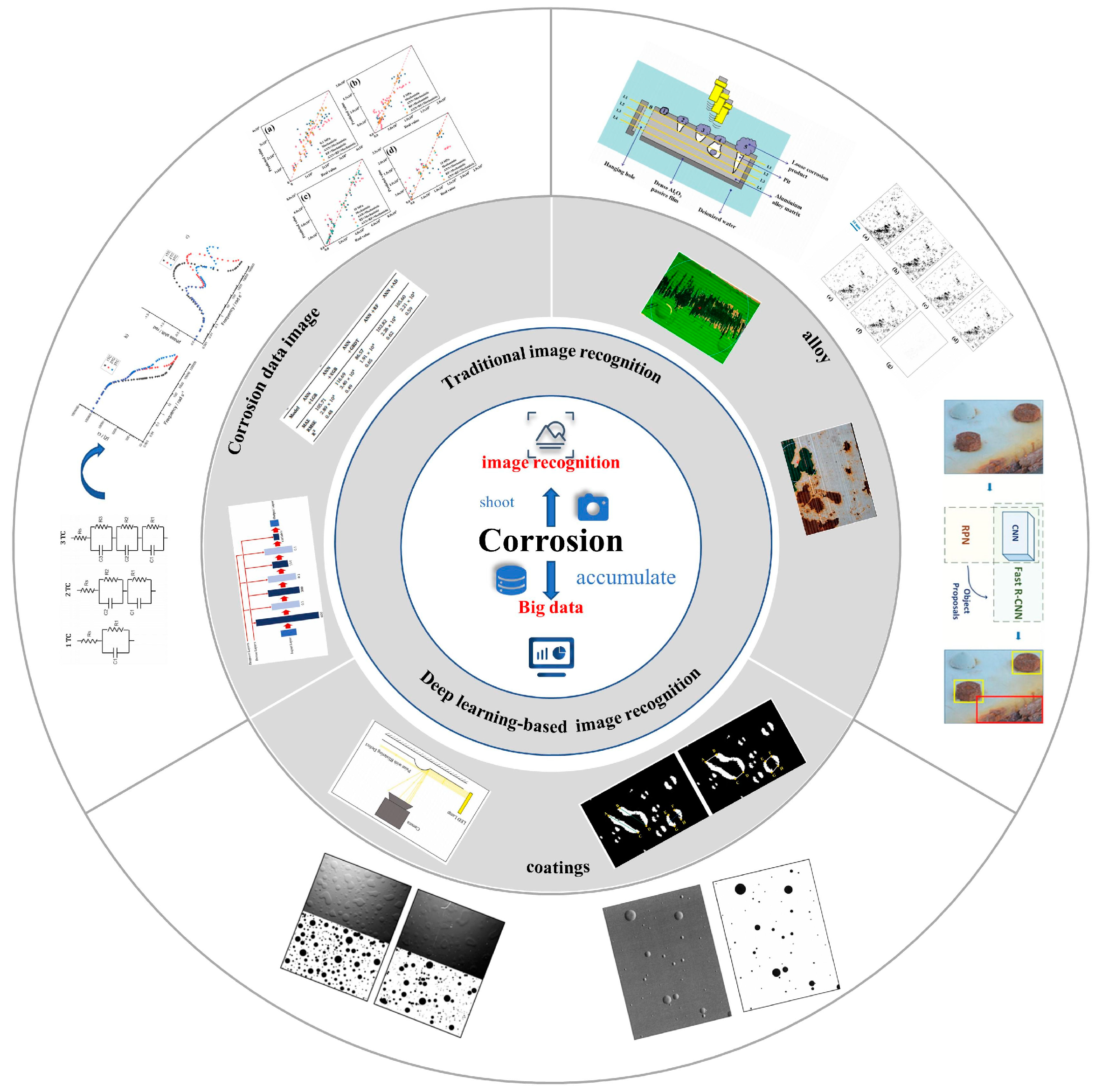
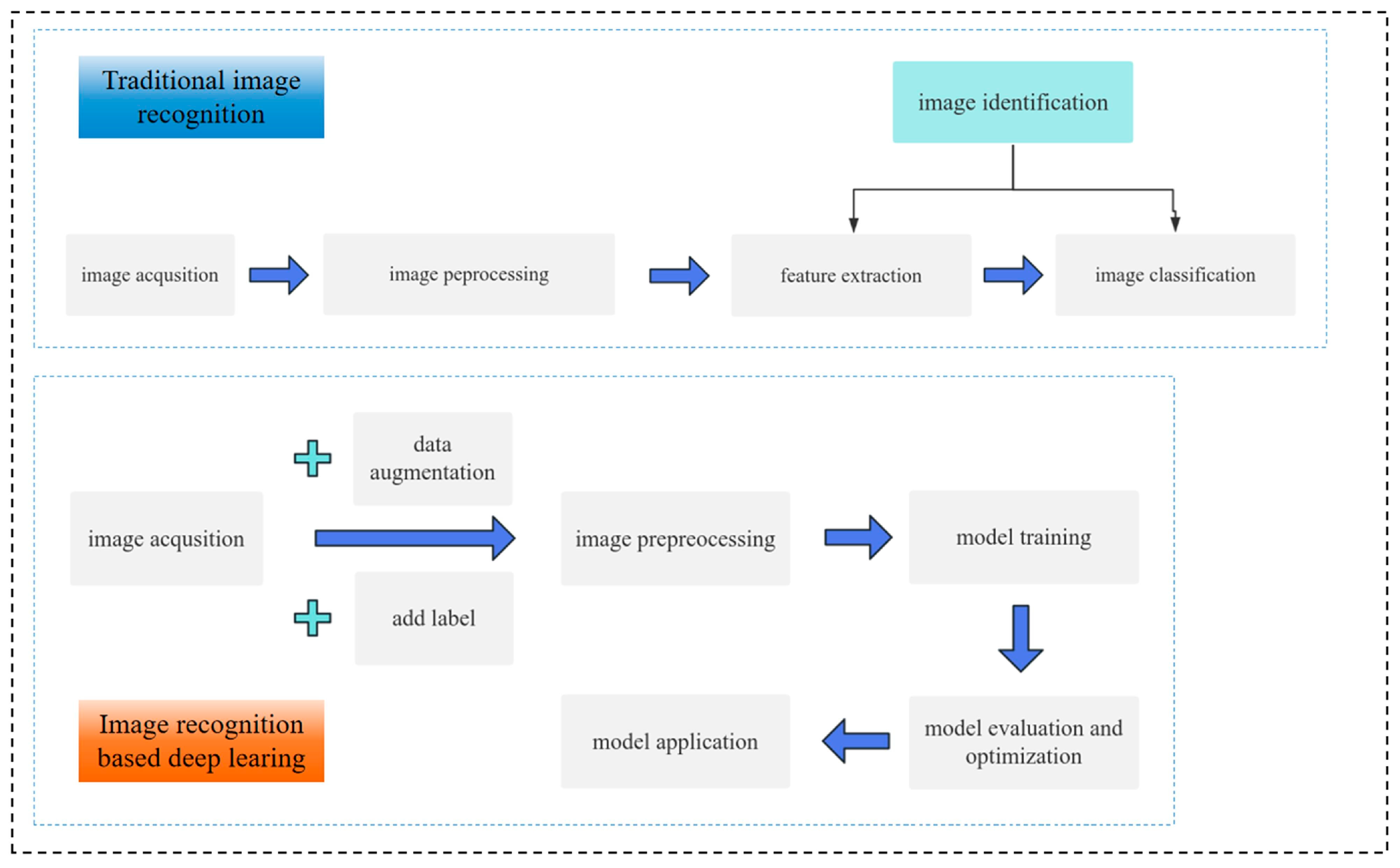
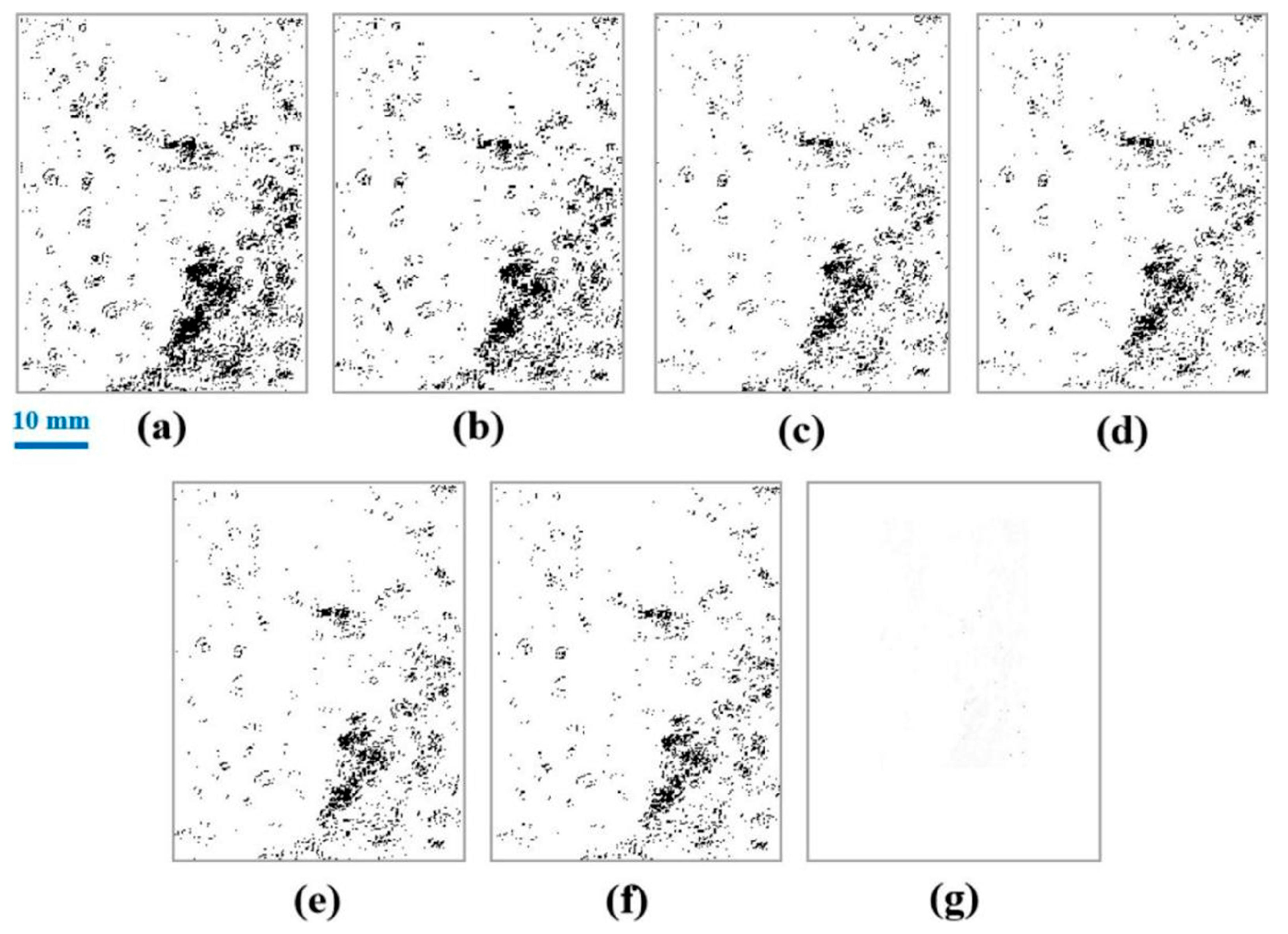
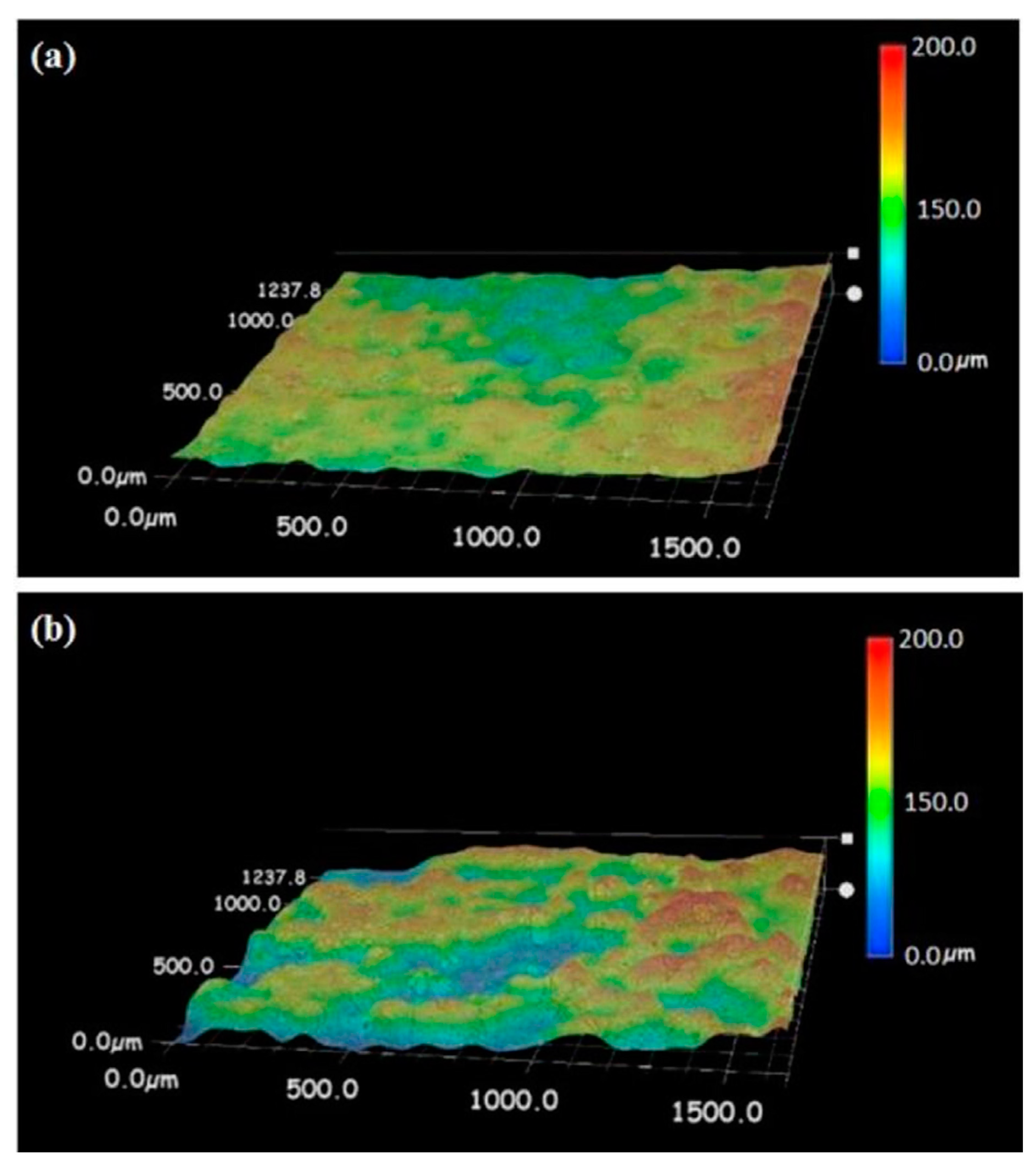

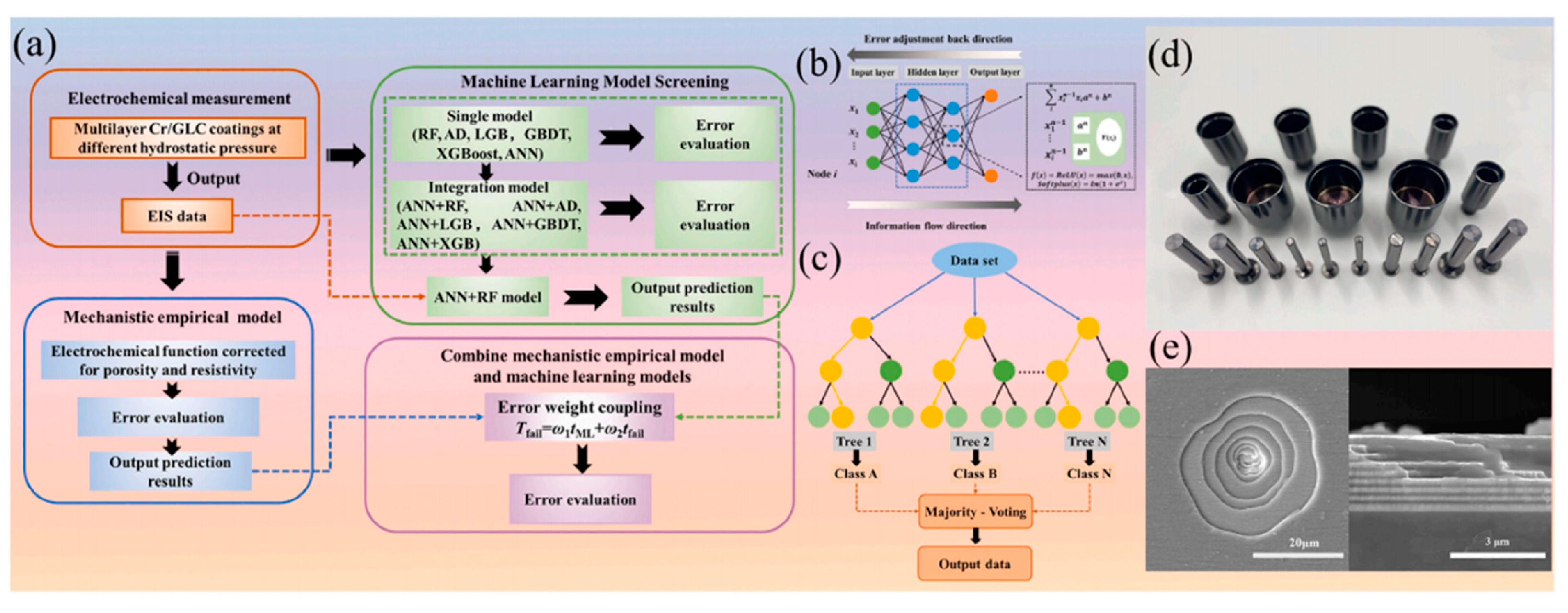


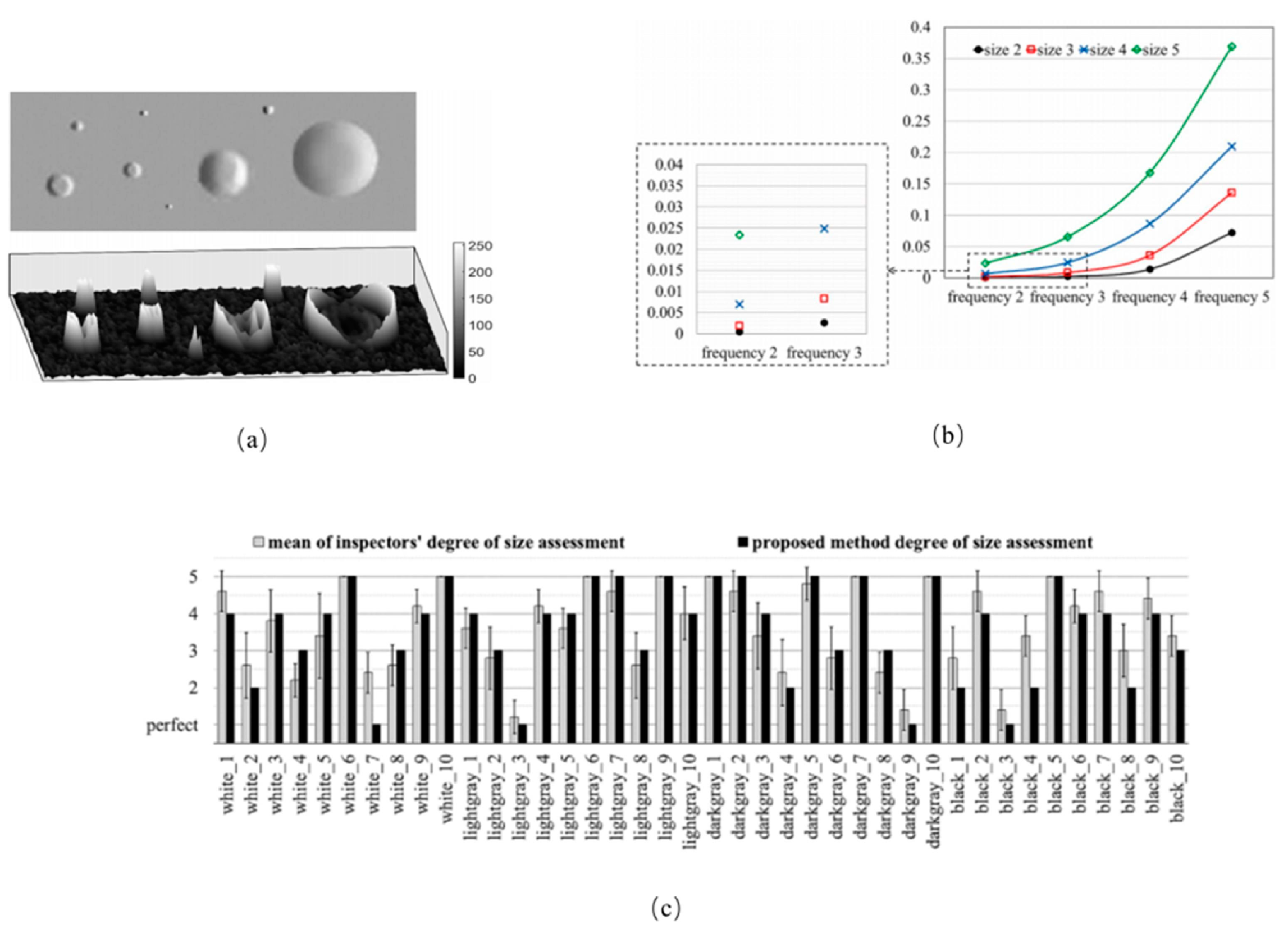
| Method | Materials | Main Content | Author/Ref. | Year |
|---|---|---|---|---|
| Method based on wavelet transform | Al 7075-T76 | The electrochemical noise signal was analyzed to reveal the characteristics of the potential signal in detail and monitor the occurrence of local corrosion | Liu [23] | 2001 |
| Aero-aluminum alloy | The formation and growth of corrosion pits were modeled and simulated. The corroded panels were evaluated by wavelet-based image processing | Pidaparti [53] | 2007 | |
| Weathering steel | The corrosion state of weathering-resistant steel was evaluated by combining wavelet transform with the PSO-SVM technique | Yan [50] | 2014 | |
| Methods based on fractal theory | Inconel alloy 600 | The fractal dimension of pitting pits hardly changes with temperature | Park [56] | 2003 |
| Reinforced Concrete (RC) | The relationship between the crack fractal dimension, corrosion rate and steel bar diameter was established to evaluate the corrosion behavior of steel bars in degraded reinforced concrete structures | Li [57] | 2022 | |
| X80 steel | The two-dimensional/three-dimensional fractal dimension of corrosion pit increased with the increase of AC density, showing linear and exponential relationships, respectively | Fu [58] | 2019 | |
| Method based on grayscale | Galvanized high strength steel | The elliptic parameters of the binary image of the corrosion pit were extracted, and it was found that the elliptic parameters of the corrosion pit satisfy the Gaussian distribution along all directions | Xu [59] | 2016 |
| Method | Advantage | Disadvantage |
|---|---|---|
| Methods based on wavelet variations | The low-frequency region responds to the color spatial distribution and brightness differences of the image, while the high-frequency region is able to respond to the local features of corrosion. | Differences in the calculation of wavelet energy entropy may lead to differences in corrosion image processing |
| Approach based on typing theory | It has the ability to recognize features of non-traditional Euclidean geometry in an image and to distinguish differences in roughness in image information. | The fractal dimension may be the same for different images and cannot be used alone as a criterion for judging images |
| Gray scale image based approach | It has the ability to reduce complexity, increase computing speed, and improve detail clarity. | Incomplete representation of information and inability to process corrosion with color characteristics |
| Method | Concrete Algorithm | Materials | Main Content | Ref. |
|---|---|---|---|---|
| Traditional method | Method based on grayscale | Alkyd paint | The bubble size and area ratio are determined based on the gray image, so as to determine the bubble grade | [45] |
| Method based on color space | Coatings on offshore wind platforms | Quantitative recording and rating of coating deterioration processes | [52] | |
| Method based on grayscale | Coatings on steel bridge | Multiresolution pattern classification (MPC) was used to analyze the surface coating images of steel bridges, and the proportion of coating and rust in gray images was calculated | [64] | |
| Methods based on deep learning | Deep transfer learning techniques | The coating on the ballast tank | An AI-based aided CBC evaluation system (A-CAS) was developed to identify different types of coating damage and corrosion | [66] |
| Convolutional neural networks (CNN) | PVAsilver nanoparticles (nAg/PVA) | The CNN data were compared with electrochemical measurements and scanning electron microscopy (SEM) data | [69] |
Disclaimer/Publisher’s Note: The statements, opinions and data contained in all publications are solely those of the individual author(s) and contributor(s) and not of MDPI and/or the editor(s). MDPI and/or the editor(s) disclaim responsibility for any injury to people or property resulting from any ideas, methods, instructions or products referred to in the content. |
© 2024 by the authors. Licensee MDPI, Basel, Switzerland. This article is an open access article distributed under the terms and conditions of the Creative Commons Attribution (CC BY) license (https://creativecommons.org/licenses/by/4.0/).
Share and Cite
Wang, X.; Zhang, W.; Lin, Z.; Li, H.; Zhang, Y.; Quan, W.; Chen, Z.; You, X.; Zeng, Y.; Wang, G.; et al. Current Status of Image Recognition Technology in the Field of Corrosion Protection Applications. Coatings 2024, 14, 1051. https://doi.org/10.3390/coatings14081051
Wang X, Zhang W, Lin Z, Li H, Zhang Y, Quan W, Chen Z, You X, Zeng Y, Wang G, et al. Current Status of Image Recognition Technology in the Field of Corrosion Protection Applications. Coatings. 2024; 14(8):1051. https://doi.org/10.3390/coatings14081051
Chicago/Turabian StyleWang, Xinran, Wei Zhang, Zhifeng Lin, Haojie Li, Yuanqing Zhang, Weiyin Quan, Zhiwei Chen, Xueqiang You, Yang Zeng, Gang Wang, and et al. 2024. "Current Status of Image Recognition Technology in the Field of Corrosion Protection Applications" Coatings 14, no. 8: 1051. https://doi.org/10.3390/coatings14081051
APA StyleWang, X., Zhang, W., Lin, Z., Li, H., Zhang, Y., Quan, W., Chen, Z., You, X., Zeng, Y., Wang, G., Luo, B., & Yu, Z. (2024). Current Status of Image Recognition Technology in the Field of Corrosion Protection Applications. Coatings, 14(8), 1051. https://doi.org/10.3390/coatings14081051


.jpg)




